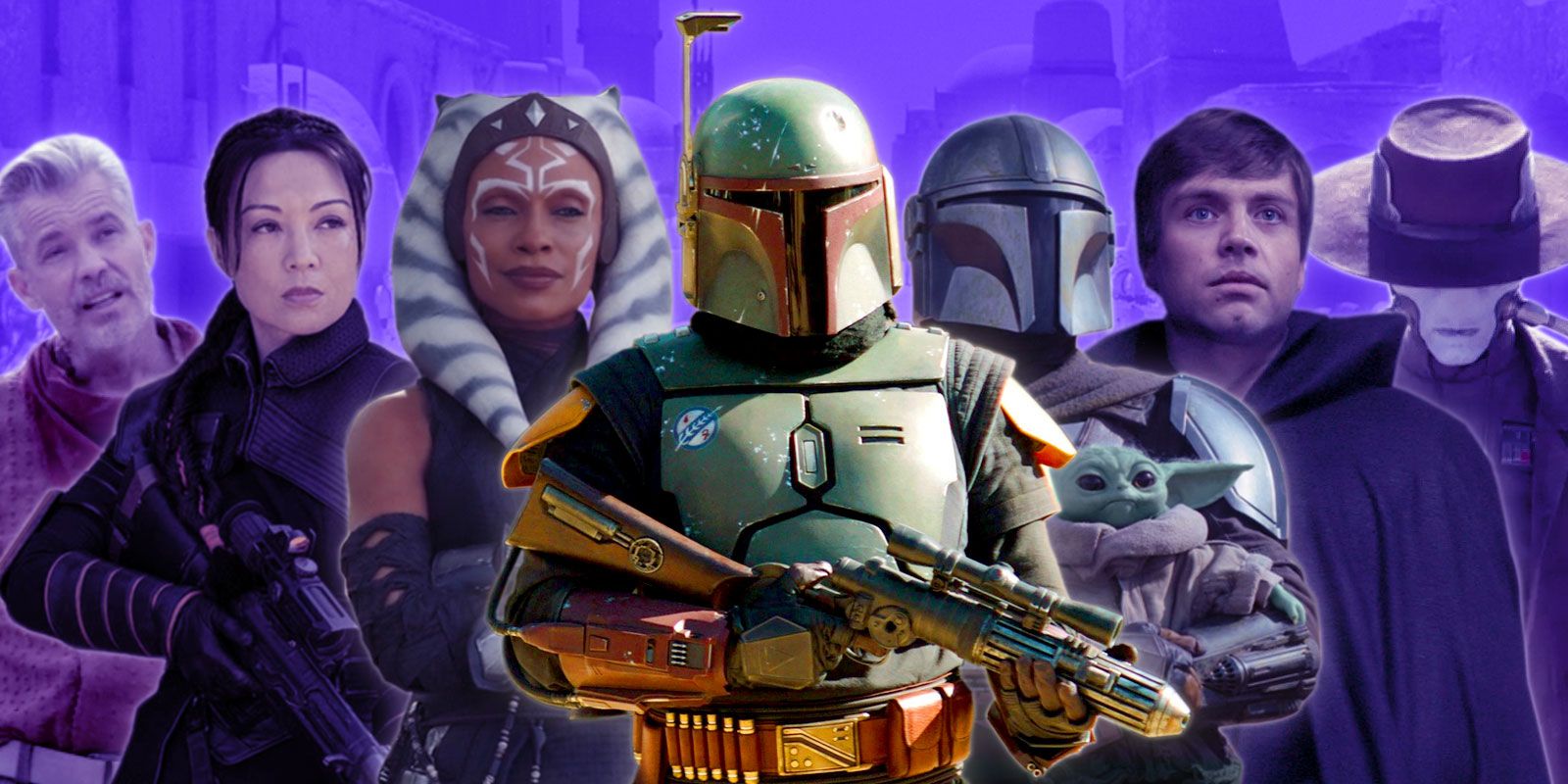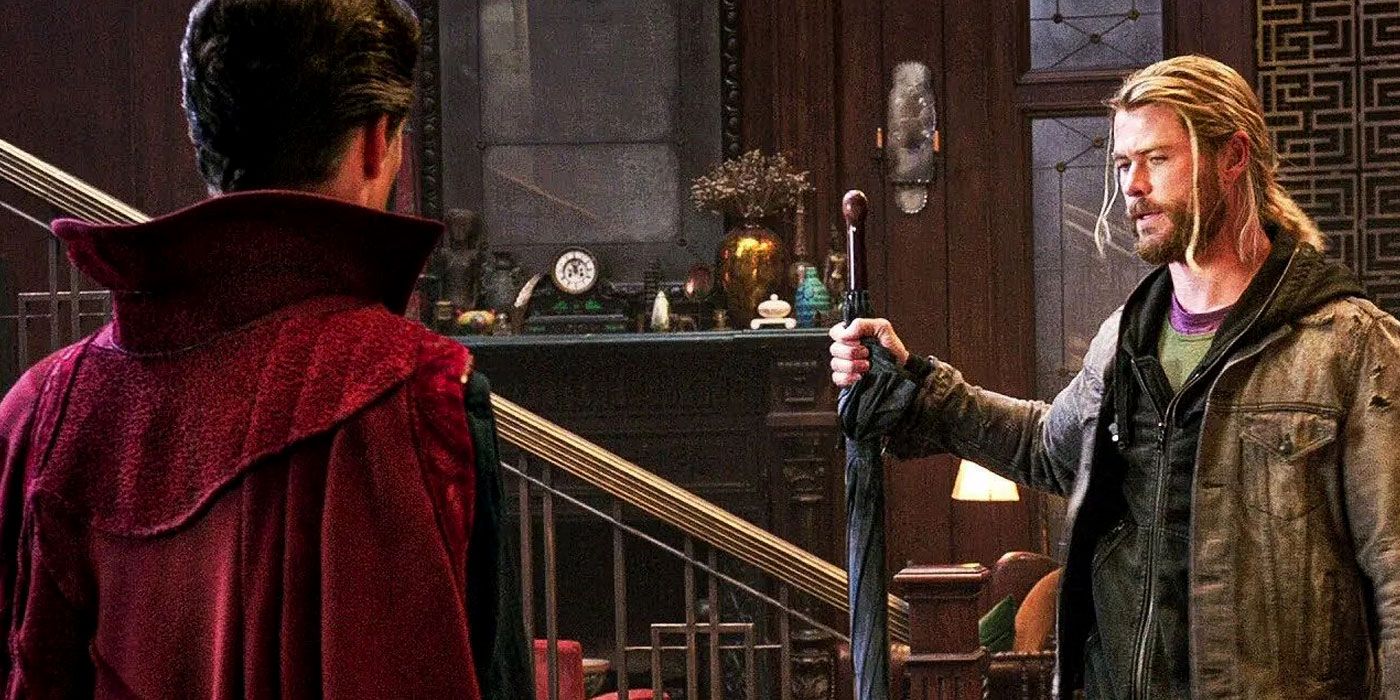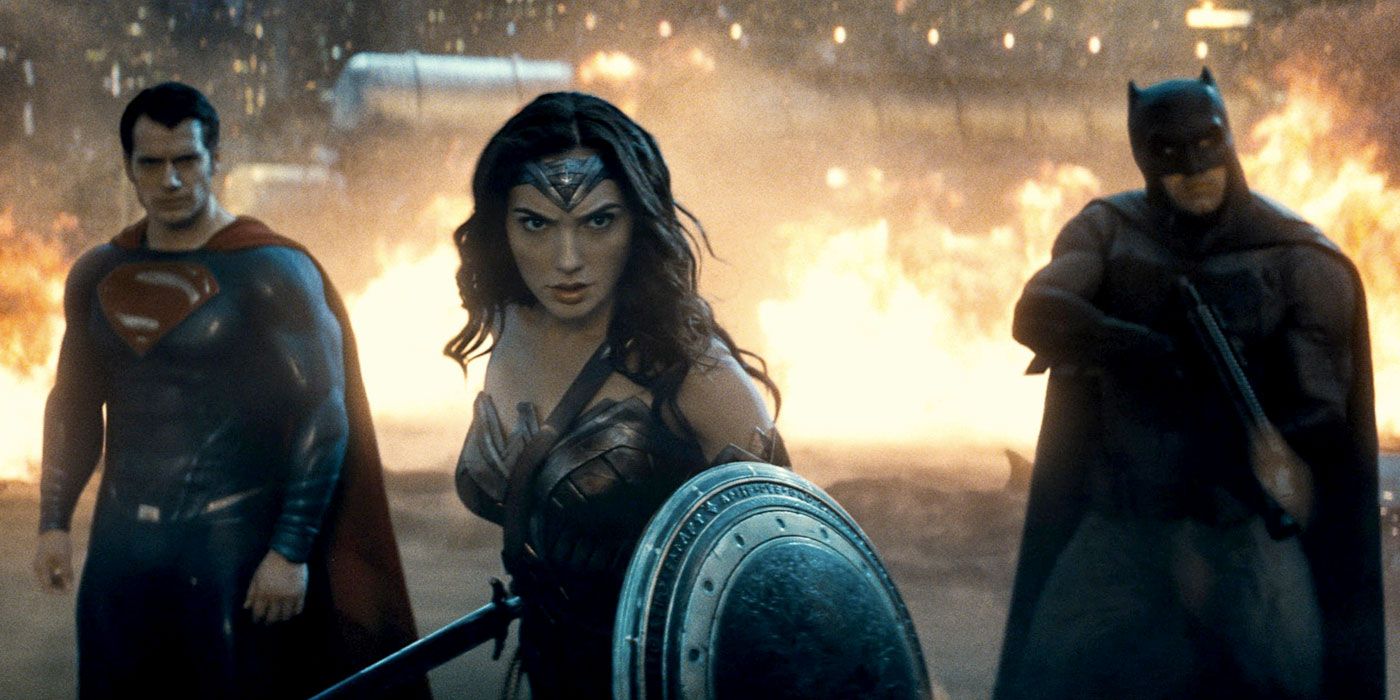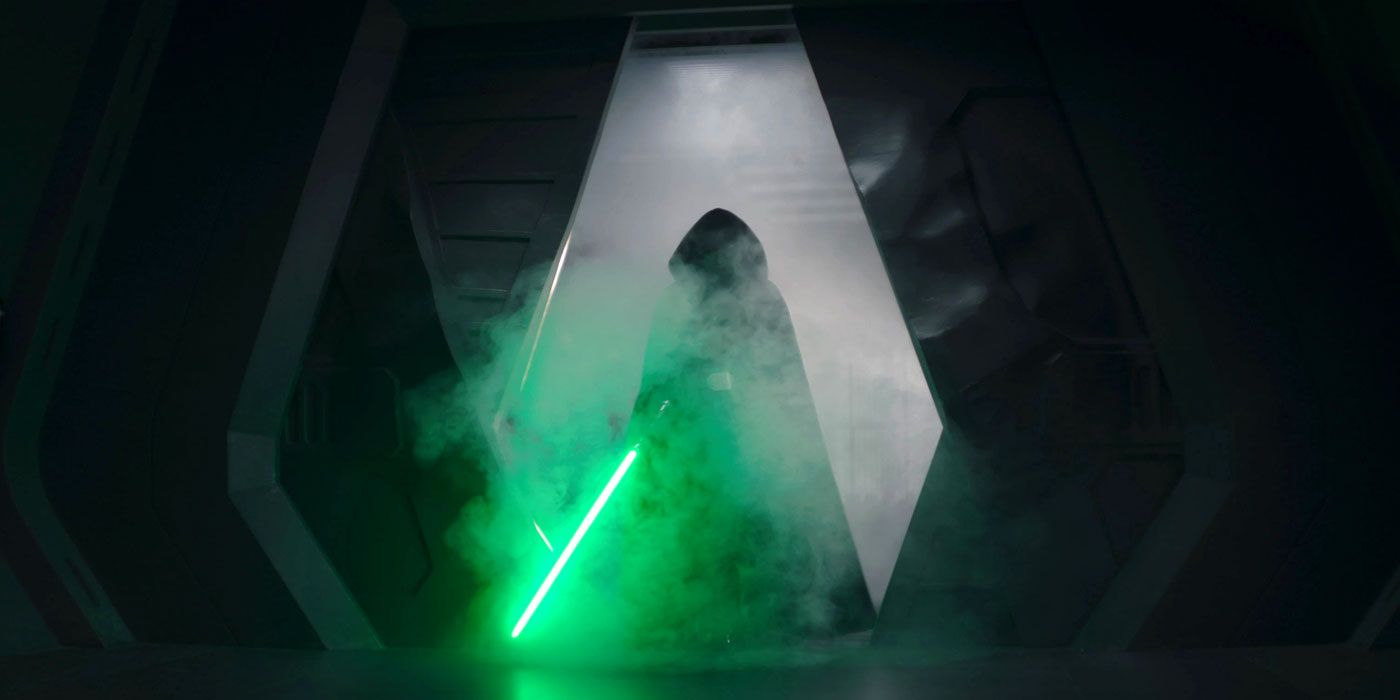Watch out! This article contains spoilers for The Book Of Boba Fett.
The biggest problem in The Book Of Boba Fett is a pitfall that all shared universe stories run the risk of stumbling into. The first Disney+ Star Wars TV show of 2022, The Book Of Boba Fett follows what happened to the titular main character after the events of Star Wars: Return Of The Jedi. The show has elicited mixed reviews from critics and, while some have praised the introduction of new elements into Star Wars canon, others have noted that it often feels as if Fett is a side character in his own show. The problem, simply put, is too much emphasis on the shared universe aspect of Star Wars.
Shared universes in TV and cinema are not new. The best-known early example is probably the Toho Shared Universe, which contained famous kaiju like Godzilla, Mothra, and Rodan. The advent of television-based shared universes happened much more recently, arguably beginning with Star Trek: The Next Generation, which shared prominent characters with original Star Trek as well as other 1990s TV shows like Star Trek: Deep Space Nine and Star Trek: Voyager. Star Wars has played a role in forging the shared universe model of stories too, with a huge web of interconnected stories being made as part of the Star Wars Expanded Universe, although most of this has since been rendered non-canon as Star Wars Legends.
With this in mind, it seems strange that The Book Of Boba Fett suffers so much because of its shared universe. However, the series contains so many shared universe references that it becomes over-encumbered by them, squeezing in so many other characters from various stories that it ends up suffocating its own central plot. It often feels as if the writers lacked confidence in their own original material and resorted to including well-known characters from other stories to try and build as much fanservice as possible, but the result is a lack of investment in what’s supposed to be the main narrative. The final product is a show which may please audiences who enjoyed tangentially related but popular shows like The Mandalorian but will ultimately frustrate people who wanted a story about Boba Fett. This feels strange to realize, considering Fett's name is in the show's title. However, this issue, while obvious in The Book of Boba Fett, is far from unique to the Star Wars spin-off.
How The MCU Perfected The Shared Universe Model
Even those who don’t like the Marvel Cinematic Universe and its stories can’t deny its success. Beginning with Iron Man in 2008, the MCU has grown into the gold standard for shared universe stories. In 2022, there’s so much intertextuality in the movie and TV franchise that it’s easy to forget how its beginnings weren’t too different to the superhero movies that came before it; self-contained stories that occasionally hinted and teased at how they were smaller parts of a much larger world. This is likely the key to the success of the early movies, many of which weren’t particularly exceptional in their own right. In fact, earlier Marvel Cinematic Universe movies that leaned too heavily on the shared universe model, like Iron Man 2, are often considered among the least memorable.
As the MCU has blossomed, it’s become much more normal to see characters from one story appear in another, but the MCU has largely remained faithful to its original premise of telling stories that are self-contained. Characters may appear without introduction, but only ever when it’s logical for them to be there. Doctor Strange showing up at the beginning of Thor: Ragnarok is a perfect example. His inclusion makes sense in the story and the audience is immediately shown everything they need to know about him — Doctor Strange is a wizard, his only goal is to protect Earth, and he’s otherwise a neutral party in the story. Once his role in the movie is over, he leaves and isn’t shown again. There's no reason to give him any more screen time than the story needs from him.
This is the golden rule that the MCU abides by in all of its stories — the writers never pull the focus away from the hero. There’s always a central character to be emotionally invested in, and the story always revolves around that character’s perspective. The Hulk is a major character in Thor: Ragnarok, but it never stops being Thor’s story. Doctor Strange is essential to the plot of Spider-Man: No Way Home, with its many villains, but the movie is always sharply focused on telling Spider-Man’s story.
Why Other Shared Universes Fail To Beat The MCU
Writers of other stories have, sadly, failed to replicate these core ideas and the most disappointing example is the DCEU. With iconic characters like Superman, Wonder Woman, and The Flash, the early DCEU movies had no right to be so weak. The problem with the weakest DCEU movies is an overemphasis on the expanded universe at the expense of telling a satisfying story. By far the most egregious example is Batman v Superman: Dawn Of Justice, which only seems to exist to set up the Justice League movie and even its unmade prospective sequels. Wonder Woman feels awkwardly misplaced in the story, only serving to give exposition about future Justice League members, and then take part in a boss fight she shouldn’t really have been involved in.
The DCEU's big mistake is, essentially, trying to do too much too soon, largely ignoring the self-contained, tightly focussed storytelling which made the MCU so compelling. Instead, the goal was seemingly to rush into a team-up movie as quickly as possible, throwing three of its central heroes together on-screen in the second movie and relying on audiences to already know everything about them. Since then, the DCEU has seemingly tried to distance itself from its early failings, focussing more on loosely connected stories in the same shared universe. In so doing, it’s inadvertently fallen into a style that more closely resembles the MCU and as a result, even with its early continuity dead, newer DCEU stories like Shazam and Peacemaker have been much better received. Continuing in this direction, and developing a style distinct from the familiar “quippy” Marvel dialogue which many viewers are starting to find tiresome, the DCEU is finally finding the success it deserves.
There are a few other shared universes ongoing in movies and TV, with notable examples being Sony’s Spider-Man Universe, where the Venom movies are set, and the successful, if not especially memorable, MonsterVerse. With relatively few stories in each, it’s perhaps too early to judge the success of these, but they seem to be largely following the MCU’s style so far. Venom was an entirely self-contained story, and Venom: Let There Be Carnage hinted at a larger world, with the introduction of the Ravencroft Institute, but didn’t waste time elaborating on it. A wise creative choice, because that elaboration would’ve been a distraction from the story being told.
Book Of Boba Fett Shows The Problem With Shared Universes
Unfortunately, in The Book Of Boba Fett, Star Wars has shown that it’s neither interested in telling self-contained stories, nor in keeping the focus on the main character. The shared universe takes priority over the story. While the idea of a shared universe is to make stories feel like a small part of a larger whole, squeezing too many disparate characters together into a single story has the opposite effect, making the entire story universe feel that much smaller.
First and foremost, Book Of Boba Fett is the opposite of self-contained. Nearly every major character already has an extensive history in the sprawling transmedia franchise of Star Wars. Where shows like The Mandalorian introduced and developed brand new characters who viewers became deeply invested in, Book Of Boba Fett relies almost exclusively on characters who at least some audience members will recognize. At the same time, the story barely seems to care about its original characters. Two significant characters are killed off-screen, and two significant characters aren’t even given names. The Tusken warrior who’s so important at the story's opening falls into both of these categories.
The deeply interconnected nature of the story isn’t necessarily a problem in itself. The presence of characters like Fennec Shand or Black Krrsantan is woven into the story well enough that they don’t need any introduction beyond what’s shown. The real problem is that Book Of Boba Fett breaks the golden rule — it drags the focus away from the main character. Episodes 5 and 6 barely even involve Boba, focussing almost exclusively on Din Djarin and Grogu from The Mandalorian. They also do their best to shoehorn in as many characters as possible from other Star Wars media, like Star Wars: The Clone Wars, Star Wars: The Bad Batch, several Star Wars comics, and even Chuck Wendig's Star Wars: Aftermath trilogy of novels. By the time the finale arrives, early emotional investment in Boba’s story has been squandered, after most of the previous two episodes were literally set on different worlds.
Star Wars' Future Risks Making Its Shared Universe Problem Worse
One of the most successful collections of Star Wars stories is the animated show, Clone Wars, where the anthology storytelling style is one of the most enjoyable aspects of the series. It isn’t told in chronological order, preferring to dive in and out of the experiences of different characters during the events which followed Star Wars: Attack Of The Clones. While the central characters of the series are Anakin Skywalker, Obi-Wan Kenobi, and Ahsoka Tano, there are entire episodes where none of them appear. The very first episode, for example, is entirely about Master Yoda and a group of clone troopers. The current run of Star Wars live-action shows feels like it’s trying to replicate the success of Clone Wars but, in so doing, it misses what made Clone Wars so appealing. Each short story in Clone Wars carefully focuses on few characters, and those characters take center stage until that story is finished.
Star Wars has an ever-increasing roster of stories across a variety of different media. While this gives a much greater potential to include tie-ins and cameos with characters from other stories, it also carries the risk of overloading stories with characters who don’t really belong there. 10 of the major characters from Book Of Boba Fett, including Boba himself, are exactly this kind of tie-in character. Their collective backstories span four movies, four TV series, three novels, and a plethora of comics. Between overloading the story with cameos and pulling the focus haphazardly between characters, important elements are overlooked or only hinted at. Cobb Vanth’s connection to Fett is barely referenced. Cad Bane feels like barely more than a henchman than a saga-spanning antagonist. Both die so quickly after their first appearances that their last-minute inclusion in Book Of Boba Fett feels utterly bizarre.
As the Star Wars TV shows seem inevitably headed towards team-up stories against major villains like the Pyke Syndicate and General Thrawn, they risk falling into the same pitfall which nearly killed the DCEU — giving the shared universe priority over telling heartfelt, compelling stories. Other much-anticipated Star Wars shows due for release in 2022 are Ahsoka and Kenobi, following the two lightsaber-wielding fan-favorite characters. With their shared history, it seems inevitable that the two will meet up at some point in their stories. As they do, writers need to be wary of making the mistakes that left The Book Of Boba Fett feeling so unsatisfying. Spending too much time returning to the same cast of characters risks shrinking both the universe and emotional investment in the stories being told.
Many of the elements and characters that The Book Of Boba Fett introduced early on held lots of potential and could have developed into interesting and unique new aspects of Star Wars canon. While many viewers know and love characters from stories they remember fondly, it’s important to remember that the best stories have always been about entirely new characters. Din Djarin and Grogu were introduced in The Mandalorian and are now widely loved. The fact that The Book Of Boba Fett didn’t introduce any new characters to join them is a mistake that Star Wars writers will hopefully correct moving forwards.





